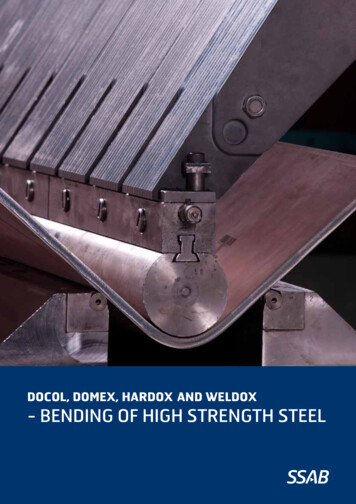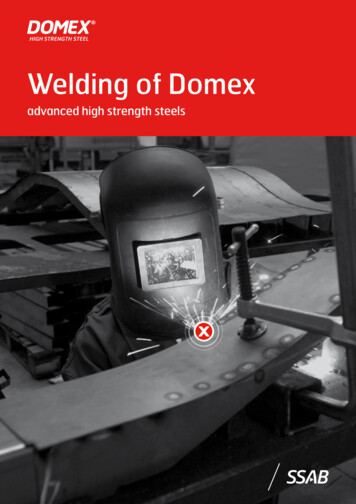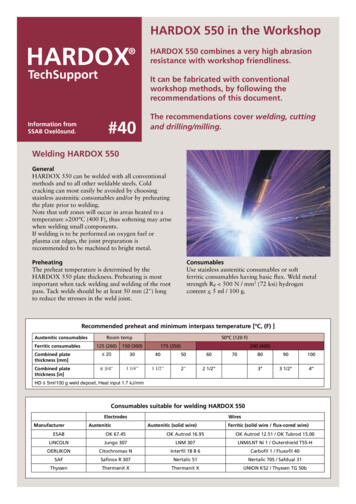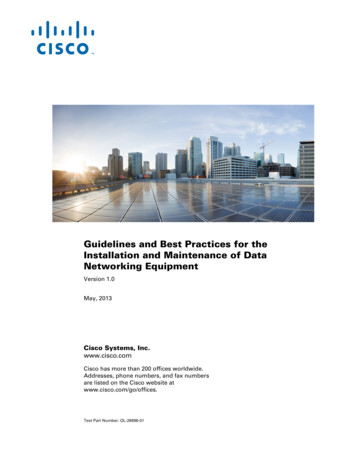
Transcription
DOCOL, Domex, Hardox and WELDOX- Bending of high strength steel
This brochure deals with bending of high strength steel for the trademarksHardox, Weldox, Domex and Docol. The content is intended as a guide, andcontains general suggestions for how to achieve the best results in bending.Bending high strength steel sheet and plate rarely proves to be difficult,however, there are certain parameters that must be considered, which aredealt with in this brochure.A material of high purity with few inclusions is of fundamental importance,in order to achieve a good bending result. SSAB’s modern processing allowsfor high standards of surface quality, tolerances and mechanical properties.Preparation before bending Check the rolling direction of the plate. If possible, orientthe rolling direction perpendicular to the bend line. Theplate can often be bent tighter this way, than with the bendline parallel to the rolling direction, figure 1. Check the surface quality of the plate. Surface damagecan worsen bendability as it can be the cause of fractures.For heavy plates, defects on the plate such as scratches andrust can often be removed with careful grinding. Grindingscratches shall preferably be placed perpendicular to thebend line. Thermal cut and sheared edges should be deburredand rounded with a grinder. Check the condition of the tools. To avoid excessive tool wear, tooling should be harderthan the work piece. Check that the tools and tool setup are in linewith the given recommendations in this brochure.FIGURE 1 Bending at right angle to the direction of rolling.Grind away any blemishesbefore bending. Shearedand thermal cut edgesshould also be deburred.Bending lineRpDirection of rollingtRdw2The edges of the die openingshould always be as hard as,or harder than the plate beingbent, in order to avoid excessivedamage to the die.A simple way of achieving thisis to mill grooves in the die edgesand fit lubricated round rods of, forexample, hardened steel into thegrooves.The edge radius of the dieshould be at least half the platethickness.
To considerTools Pay attention to safety and follow the local safety directions. Only qualified people may be by or in the vicinityof the machine. When high strength steel is being bent,nobody should stand in front of the press brake. Check that the punch together with the workpiece donot bottom out in the die. Consider springback. Avoid rebending to correct theprofile angle. The exposure of a material to previousforming processes reduces its bendability to a great extent. Bending force, springback and, in general, minimumrecommended punch radius increase with the strengthof the steel. In many cases for Hardox and Weldox, the identity of theplate is stamped perpendicular to the rolling direction.Avoid placing the plate so that the stamping occurs inthe bend line, due to the risk of cracking Blast cleaning can have a negative effect on bendability.Recommendations for Hardox and Weldox products arebased upon tests with blasted and painted surfaces. Therecommendations for Domex and Docol are based ontests without a blasted surface. High strain rate may cause local a temperature increasein the bend. This could have an adverse impact on thebendability, especially for thicknesses above 20 mm.If possible, reduce the punch speed, in order to decreasethe temperature difference within the work piece.Die widthSpringback increases with increased die width, while punchforce is reduced. Make sure that the opening angle of the dieallows for over-bending, without bottoming out, to compensate for springback. An increased die opening width can inmany cases lower the strain level in the bend. Also, make surethat there is enough room for the chosen punch togetherwith the workpiece, in the die, during bending, withoutdeforming the die. The minimum recommended die openingwidth are shown in tables 2 and 3.The die edge radius should be at least half the plate thickness. Alternatively, the die width should be increased in orderto minimize pressure on the die edge radius, and consequentlyreduce the risk of die marks.FIGURE 2 Bend.FIGURE 3 Separation of the plate during bending.TensionsideBendlinePunchThe suitable punch radius, along with the die width, is themost important parameter. When bending high strength steel,the final inner radius often becomes somewhat smaller thanthe radius of the punch, figure 3. When there is low frictionbetween plate and tools, the phenomenon becomes moreobvious.For steel with yield strength over approximately 500 MPa, apunch radius of the same size or slightly larger than the desiredbending radius is recommended. Tables 2 and 3 on page 7 showthe minimum recommended punch radius when bending to 90 .tCompressionsideRdSeparation of theplate and punch.w3
Condition of toolsDue to the increased contact pressure between plate and toolswhen bending high strength steel, wear on the tools increasessomewhat. Check at regular intervals, that the punch radiusand die edge radius are both constant. For bends that havecracked in a construction, the crack has in many cases propagated form the compression side of the bend, figure 2. This canoften be attributed to poor condition of the punch. The edgesof the die should remain clean and undamaged.Machine stabilityRequired punch force is often great when bending highstrength steel. The static friction coefficient is typically higherthan the kinetic. This can cause the plate to lock over the edgeof one die edge radius, and at the same time, slide over theother one. In this way, the workpiece swings down into thedie in a discontinuous way during the bending process. Thisphenomenon, called stick-slip, can result in higher strainsover the bend. Use a stable machine and steady tool fastening.Lubrication of the die edge or use of a rotating die edgeradius can be helpful, avoiding stick-slip and also loweringthe punch force.CrowningCrowning compensates for the elastic deflection of the bending machine under load, figure 4. The central part of punchand die deflects the most. By crowning, the deflection canbe compensated for, thus achieving the same bending anglealong the entire blank length. If the bend profile becomescurved along the bend line this cannot be compensated forby crowning.After unloading compressive stresses arise on the stretchedside, at the same time as tensile stresses appear on the compressed side, figure 2. The stress distribution over the platethickness causes longitudinal stresses. It is those stresses thattend to curve the profile. The magnitude of curvature dependsmainly on the flange height and the profile stiffness.Additional considerations have to be made when settingthe crowning at stepwise bending of long profiles.FIGURE 4 Crowning.ABC4A Straight profile.B Curved profile along bend line.C Curved profile angle.
Bending ForceTABLE 1 Typical tensile strength values to calculate bend force.To make an estimation of the force needed during bending,we pay attention not only to the bend length, plate thickness,die width and tensile strength, but also the changing momentarm during bending. The peak load is assumed to be reachedat a bend opening angle of 120 with normal friction (nolubrication). Trial tests are always recommended.P b t 2 Rm(W-Rd-Rp) 9 800Type of steelTypical Tensile Strength (MPa)S355550WELDOX 700860WELDOX 9001 010WELDOX 9601 060WELDOX 11001 440WELDOX 13001 530HARDOX 4001 250HARDOX 4501 400HARDOX 5001 650DOMEX 700 MCP Bend force, tons (metric)t Plate thickness, mmW Die width, mmb Bend length, mmRm Tensile strength, MPa (table 1)Rd Die entry radius, mmRp Punch radius, mmThe SSAB Bending Formula is verifiedby tests for 90 bends, see figure 5. Example 1A certain press brake is just capable of bending a 20 mm thickEN10025 – S355 steel plate in a die with a 200 mm wide opening,and die entry radius of 15 mm. The punch radius is 40 mm.If the same die and punch is used and the bend length is the same,how thick a HARDOX 400 plate is the press brake capable to bend?The bending forces should be same, and only the plate thickness (t)and tensile strength (Rm) will differ. Substituting in the above formulaand simplifying: 202 x 550 t2 x 1 250The thickness (t) of the HARDOX plate will be 13.3 mm.The R/t ratio will then be 40/13.3 3.0. According to table 2,the Hardox 400 plate can be bent transverse rolling directionwith this punch radius. The W/t ratio for HARDOX 400 plate will be200/13.3 15.0 which, according to table 2, is satisfactory.830DOMEX 9601 100DOMEX 11001 380DOCOL 600 DP/DL660DOCOL 800 DP/DL860DOCOL 1000 DP1 090DOCOL 1200 M1 300DOCOL 1300 M1 400DOCOL 1400 M1 510DOCOL 1500 M1 600Example 2A 2000 mm long bracket is to be produced by bending plate.The choice lies between using:a) 10 mm thick plate of EN10025 – S355 with a typical tensilestrength of 550 MPa,orb) 7 mm thick plate of WELDOX 700 with a typical tensilestrength of 860 MPa.In both cases, an existing die with a 100 mm wide opening and die entryradius of 10 mm, is to be used. The punch radius is 14 mm in both cases.What press force will be needed for each steel grade?For S355 P 2000 10 10 550(100–10–14) 9 800For WELDOX 700 P 148 ton2000 7 7 860(100 – 10 – 14) 9 800 113 tonSince the plate thickness has a greater influence than the strength, theforce needed for bending WELDOX-plate in this particular case is lower.5
FIGURE 5 Bending Force (ton/m)700Hardox 450 (transverse), 40 mmHardox 450 (along), 40 mmWeldox 700 (transverse), 40 mmWeldox 700 (along), 40 mm600Hardox 450 (transverse), 20 mmHardox 450 (along), 20 mmCalculated (SSAB Bending Formula )Weldox 700 (transverse), 20 mmWeldox 700 (along), 20 mm500Domex 420 MC, 10 mmDomex 600 XP, 8 mmDomex 600 XP, 8 mmDomex 1200, 5 mm400Domex 960, 5 mmDomex 700 MC, 5 mmDomex 700 MC, 5 mm300Domex 700 MC, 5 mmDomex 355 MC, 5 mmDomex 355 MC, 5 mmDomex 700 MC, 4 mm200Domex 355 MC, 2 mmDocol 1200 M, 1 mmDocol 380 LA, 1 mm10000100200300400500600700MeasuredThe SSAB Bending Formula is verified by tests performed within a wide range of thicknesses and grades,the specimens are bent to 90 . Tooling setups are in line with SSAB’s bend recommendation.SpringbackSpringback increases with steel strength and the ratiobetween die width and plate thickness (W/t). Material yieldstrength has the biggest influence.When bending, a varying residual stress distribution isachieved over the bend cross section. The plastic strain leveland the distribution of these stresses will control the tendencyfor springback. All springback is fully elastic.To compensate for springback, the die should be shaped insuch a way to allow overbending without coining the material.It is very difficult to accurately predict the springback of amaterial when bending, since this depends to a large extent oneach unique tool setup. That is why trials are recommended.For thinner plate or sheet (t 10 mm), an estimation of thematerial’s springback, in degrees, can be achieved by dividingthe tensile strength (MPa) by 100.A precondition is that the die width is approximately10–12 x the plate thickness.6Parameters that affect springback: Yield strength of the material – higher yield strength causesgreater springback. Punch radius – increased punch radius will cause greaterspringback. Die width – larger die width causes greater springback. The strain hardening of the material. Friction between plate and tools – low friction may causeless springback.
Bend recommendationsSince SSAB’s products are developed and specialized fordifferent types of use, bend tests and evaluation of these varysomewhat.For products in the Hardox, Weldox and Domex ranges,the minimum recommended relationship between the punchradius and plate/sheet thickness (R/t) is shown in table 2.For Docol products, the relationship between minimuminner radius and sheet thickness (Ri/t) is shown in table 3.These bend recommendations are based on bend tests of onestep to 90 after unloading. Die opeing width are guidelinesand may vary somewhat without affecting bending results.Tables 2 and 3 shows a small selection from SSAB’s productrange. For information about other materials and moretechnical information, please contact Tech Support or visitwww.ssab.com.Weldox and Hardox can be delivered with guaranteedbending performance according to Accusteel Technology. Formore information please contact your local SSAB representative.TABLE 2 Bend recommendations for Hardox, Weldox and Domex are based on dies with rolls and normalfriction (no lubrication). R/t stands for punch radius (R) divided by sheet thickness (t).Thickness (t) (mm)Transverse To rollingdirection Minimum R/tAlong rollingdirection minimum R/tDie openingWidth (W) W/tWELDOX 700t 88 t 1515 t 20t 201.51.52.02.52.02.02.53.010101213WELDOX 900/960t 88 t 1515 t 20t 202.53.03.04.03.04.04.05.012141416WELDOX 1100t 88 t 1515 t 20t 203.03.53.54.53.54.54.55.013151516WELDOX 1300t 88 t 153.54.04.54.51515HARDOX 400t 88 t 1515 t 2020 t 502.53.03.04.03.04.04.05.012141416HARDOX 450t 88 t 1515 t 20t 203.03.53.54.53.54.54.55.013151516HARDOX 500t 88 t 1515 t 20t 203.54.04.55.54.54.55.06.015151618DOMEX 700t 33 t 6t 60.81.21.60.81.21.6101010DOMEX 9603 t 63.03.012DOMEX 11004 t 64.04.014TABLE 3 The bend recommendations for Docol are based on fixed die edges and normal friction(no lubrication). Ri /t applies for all bend directions. Ri /t stands for inner radius on the sheet (Ri )divided by sheet thickness (t).Thickness (t) (mm)Minimum Ri /tDie opening Width (W) W/tDOCOL 600 DP/DL0.5 – 2.10.510DOCOL 800 DP/DL0.5 – 2.11.010DOCOL 1000 DP0.5 – 2.12.010DOCOL 1200 M0.5 – 2.13.513DOCOL 1300 M0.5 – 2.13.514DOCOL 1400 M0.5 – 2.14.014DOCOL 1500 M0.5 – 2.14.0147
SSAB has employees in over 45 countries and operates production facilities in Swedenand the US. SSAB is listed on the NASDAQ OMX Nordic Exchange, Stockholm.For more information, contact us or visit www.ssab.comSSABSE-613 80 OxelösundSwedenSSABSE-781 84 Borlänge
DOMEX 960 1 100 DOMEX 1100 1 380 DOCOL 600 DP/DL 660 DOCOL 800 DP/DL 860 DOCOL 1000 DP 1 090 DOCOL 1200 M 1The SSAB Bending Formula 300 DOCOL 1300 M 1 400 DOCOL 1400 M 1 510 DOCOL 1500 M 1 600 tABle 1 Typical tensile strength values to calculate bend force. P Bend force, tons (metric) t Plate thickness, mm W Die width, mm b Bend length, mm R mensile











